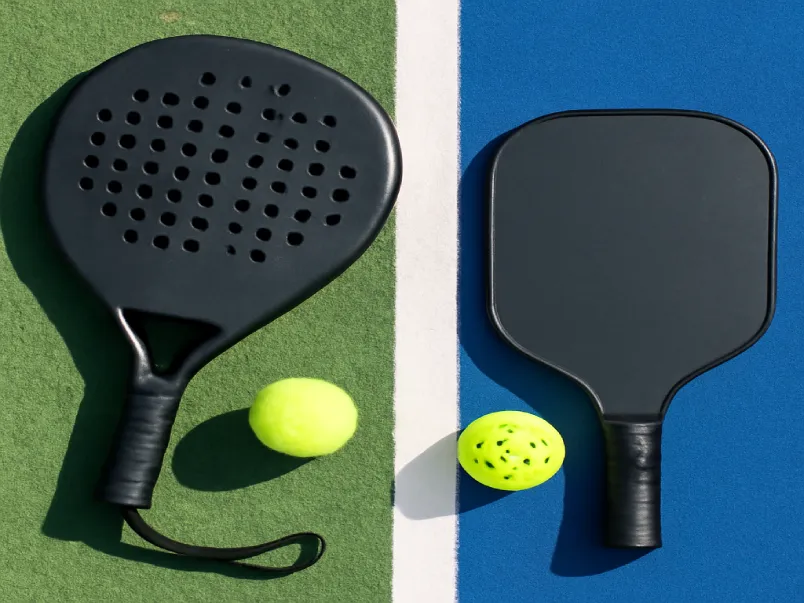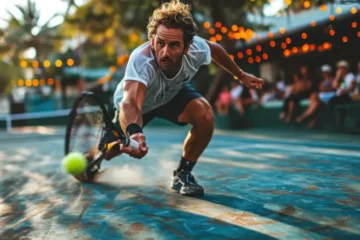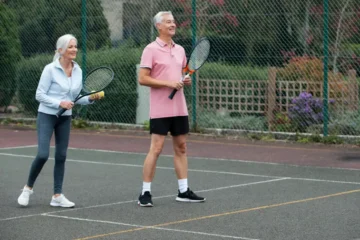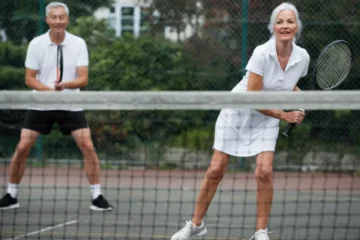A Clash of the Paddle Sports
In recent years, the world has witnessed a surge in popularity of paddle sports. From backyards to courts, people are embracing both Padel and Pickleball for their fun, social dynamics, and accessibility. Whether you’re a fitness enthusiast or just looking to try something new, these two sports present excellent ways to stay active. But here’s the big question for beginners: which one is easier to learn?
You’re ready to get out on the court, maybe even grab a paddle, but how quickly will you be able to enjoy the game, and which sport will have you playing competently in just a few sessions? Let’s take a deeper dive into the characteristics of both Padel and Pickleball to see which one is a better fit for you as a beginner.
Thesis Statement: While both are accessible, Pickleball generally has a lower initial barrier to entry and is easier to learn for absolute beginners, whereas Padel offers a unique and strategic challenge that becomes intuitive after the first learning hump.
Brief Overview of Padel and Pickleball
Both sports, while distinct in their rules and gameplay, share similarities in the sense that they offer a fun, competitive, and social atmosphere. But before diving into the specifics, here’s a quick overview:
Pickleball: A hybrid of tennis, badminton, and ping-pong, played on a small court with a plastic whiffle ball.
Padel: A blend of tennis and squash, typically played in an enclosed court surrounded by glass and mesh walls.
1. Breaking Down the Basics: Core Rules & Objectives
Pickleball: Simplicity by Design
The appeal of Pickleball lies in its simplicity. It’s a game designed for fast, fun play, with straightforward rules that make it accessible to all levels. Here’s a breakdown of the essential rules:
- The Serve: Pickleball is served underhand, which is easy for most people to master quickly. There’s no overhead serve, unlike tennis, making it less intimidating.
- The Two-Bounce Rule: After the serve, both sides must let the ball bounce once before they can return it. This rule slows down the game, ensuring that beginners can focus on positioning and control, rather than raw power.
- The Non-Volley Zone (The “Kitchen”): A unique feature of Pickleball, the kitchen prevents players from spiking the ball right at the net. This encourages more strategic, finesse-based play rather than overpowering serves or smashes.
- Scoring: While the on-court action is simple, scoring in Pickleball can be the trickiest part for newcomers. It’s based on a traditional tennis-style system, with games typically played to 11, 15, or 21 points, and points can only be scored by the serving side. However, once you get the hang of it, it’s not overly complex.
Padel: Strategic Walls
Padel offers a unique twist on traditional racket sports with the addition of walls surrounding the court. Here are some of the core aspects of Padel gameplay:
- The Serve: Like Pickleball, the serve in Padel is underhand, but with an important caveat: the ball must bounce within a designated area of the opposite side. This serves as an initial adjustment for new players who are used to the tennis-style serve.
- The Use of Walls: One of the defining characteristics of Padel is that the ball can bounce off the glass and mesh walls surrounding the court. This provides a layer of strategy that’s often unfamiliar to beginners and can make the sport challenging to grasp at first.
- Scoring: Padel uses the same scoring system as tennis (15, 30, 40, game). For beginners familiar with tennis or similar games, this system might feel more intuitive compared to Pickleball’s scoring method.
Sub-Conclusion for Section: Pickleball’s rules are designed for immediate playability, whereas Padel introduces more complexity through the use of walls and a tennis-style scoring system.
2. The Gear & The Court: How Equipment Affects Learning
Pickleball: Light and Manageable
In terms of equipment, Pickleball is all about simplicity and ease of use.
- Paddle: The paddle used in Pickleball is lightweight and solid (no strings), making it easy for players to pick up. It’s much smaller than a traditional tennis racket, and for those familiar with ping-pong, it feels very similar in terms of grip and handling.
- Ball: Pickleball uses a plastic whiffle ball, which is lightweight, slow-moving, and less bouncy. The slower ball allows players more time to react, which is especially beneficial for beginners.
- Court: Pickleball is played on a relatively small court (about the size of a badminton doubles court), which means there’s less ground to cover, and communication is simpler, particularly in doubles matches.
Padel: Hefty and Unique
In contrast, Padel equipment is slightly more involved.
- Paddle/Racket: Padel paddles are heavier and typically perforated with holes, and many come with a strap to secure the racket to the wrist. The additional weight and size of the paddle might take some getting used to for beginners.
- Ball: Padel balls resemble tennis balls but with slightly less pressure. They bounce lower, which can affect the pace of play, especially when learning the game.
- Court: The Padel court is enclosed by walls, roughly one-third the size of a tennis court. The presence of walls adds another level of complexity, as players can use them to their advantage, but it’s also something to figure out during the first few sessions.
Sub-Conclusion for Section: Pickleball equipment is less intimidating and easier to control right from the start, whereas Padel’s heavier rackets and unique court setup require some initial adjustments.
3. The Skills Hurdle: What’s Harder to Master?
Pickleball: The “Dink” is King
In Pickleball, the most difficult skill for beginners is learning how to master the soft “dink” shot, which requires precision, timing, and control. Here’s how the learning curve typically progresses:
- Easiest Skills: Hitting the ball is relatively straightforward. The light, slow ball and smaller paddle make the basics easy to grasp.
- Initial Challenge: The primary challenge for newcomers is mastering the dink shot, which involves gently hitting the ball just over the net into the opponent’s kitchen. It requires patience and precision rather than raw power.
Padel: The Wall is Your Friend and Foe
Padel’s difficulty lies primarily in its strategic use of the walls and mastering specific techniques:
- Easiest Skills: The underhand serve and basic groundstrokes are easy to grasp, especially for those with some experience in tennis.
- Initial Challenge: The biggest challenge for beginners is learning how to use the walls effectively. At first, players often struggle with the idea of bouncing the ball off walls, which requires a different mindset compared to traditional racket sports. Mastering the overhead “smash” shots like the bandeja and vibora also takes practice.
Sub-Conclusion for Section: You can likely play a fun, functional rally in Pickleball within 15 minutes, while in Padel, you may spend your first session trying to figure out how the walls work, but once you do, the game becomes much more intuitive.
4. The Physical & Social Demands
Physical Exertion:
- Pickleball: With a smaller court and less emphasis on running, Pickleball is a lower-impact sport. It’s ideal for players of all ages and fitness levels, making it accessible for everyone. The game relies more on reflexes, finesse, and precise shot placement than on physical endurance.
- Padel: Padel is more dynamic and requires more lateral movement and quick bursts of speed. It’s slightly more physically demanding than Pickleball, but still manageable for most people. It engages more muscles, offering a more complete workout.
The Social & “Fun” Factor:
- Pickleball: The simplicity of Pickleball makes it easy to jump right into the game and have fun. The game is beginner-friendly, meaning players often have a blast even from their very first session. It’s also a highly social sport, especially in doubles games.
- Padel: While the initial learning curve may take a little longer, once you get the hang of the wall mechanics, Padel can be incredibly rewarding. The “aha!” moment when you successfully use the walls in a rally is often described as one of the most satisfying experiences in sports.
Head-to-Head Summary: The Ease-of-Learning Champion
| Feature | Pickleball (The Easier Pick) | Padel (The Strategic Challenge) |
|---|---|---|
| Rules Complexity | Very Low (except scoring) | Moderate |
| Equipment Control | Very Easy | Requires some adaptation |
| First-Day Fun Factor | High | Moderate (until walls are understood) |
| Key Initial Challenge | The “Kitchen” Rule & Dinking | Using the Walls Effectively |
| Physical Demand | Low to Moderate | Moderate |
| “Playable” Level | Achieved in one session | Achieved in 2-3 sessions |
Conclusion: So, Which Paddle Should You Pick?
Restate Thesis:
For the absolute beginner seeking the fastest path to a fun, competitive rally, Pickleball is the easier sport to learn. Its simplicity is its greatest strength, offering almost immediate enjoyment for new players.
The Case for Padel:
However, don’t count Padel out. While its learning curve may be steeper at first, the tactical depth and exciting use of walls make Padel a uniquely rewarding sport once you’ve overcome the initial hump.
Final Recommendation:
- Choose Pickleball if: You want to be playing a fun, recognizable game within your first hour. You prefer minimal equipment learning curve and a sport with a low physical impact.
- Choose Padel if: You’re intrigued by a more strategic, dynamic game and don’t mind investing a session or two to master the wall mechanics. The payoff is a thrilling, unique sport that’s sure to keep you hooked.
Parting Thought:
The best sport is the one you’ll enjoy and stick with. If possible, try both! You may just find your new favorite hobby.
FAQs (Frequently Asked Questions)
1. Which is easier to learn, Pickleball or Padel?
Pickleball is generally easier to learn for beginners. Its simple rules, smaller court, and easier equipment make it ideal for newcomers. Padel, while a bit more complex due to its unique use of walls and tennis-like scoring, becomes intuitive after the first few sessions.
2. Do I need any previous experience in racket sports to play Pickleball or Padel?
No prior experience is necessary for either sport, but if you have experience with games like tennis, badminton, or ping-pong, you may find it easier to pick up either Pickleball or Padel. Pickleball, in particular, is beginner-friendly and doesn’t require much prior knowledge of racket sports.
3. Can you play Pickleball and Padel as a solo player?
Both sports are typically played in doubles for the social aspect, but they can also be played one-on-one. Pickleball has a more accessible solo play, while Padel’s smaller court and use of walls make solo play a bit more challenging.
4. What equipment do I need for Pickleball and Padel?
For Pickleball, you’ll need a lightweight paddle and a plastic whiffle ball, with a court that’s about the size of a badminton court. For Padel, you’ll need a heavier perforated racket, a padel ball (similar to a tennis ball but with less pressure), and access to an enclosed court.
5. Which sport is more physically demanding, Pickleball or Padel?
Padel is generally more physically demanding than Pickleball. It involves more lateral movement, quick bursts of speed, and uses more of your body. Pickleball, on the other hand, is less strenuous and has a lower impact on the body.
6. Which sport is better for socializing?
Both sports are highly social and typically played in doubles. However, Pickleball’s simplicity allows players to jump in and play almost immediately, which can make for quicker social interactions. Padel, while also fun and social, may require a few more sessions to fully get the hang of.
7. Can I play Pickleball and Padel as a beginner?
Yes, both sports are beginner-friendly. Pickleball is more accessible to beginners due to its simple rules and smaller court, while Padel can be a bit trickier at first because of the wall mechanics. However, both sports offer fun and rewarding experiences for beginners.




